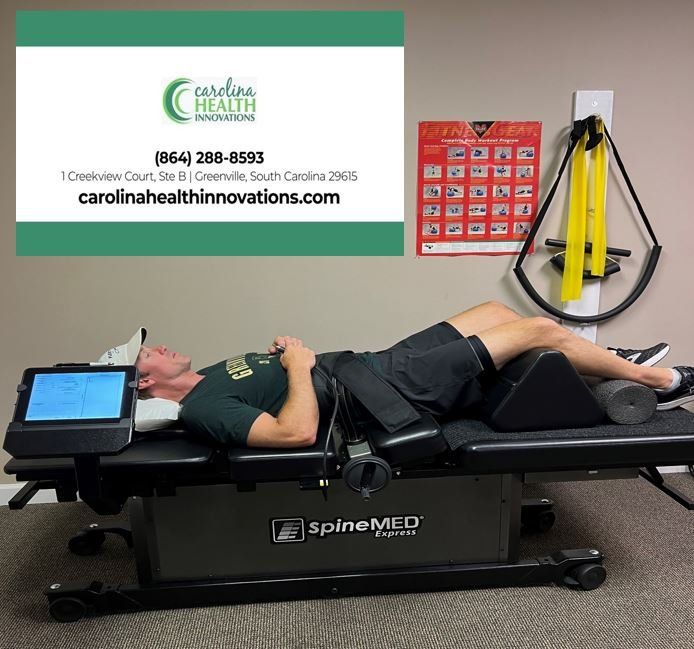Spinal Decompression
Relieve Your Chronic Back Pain THROUGH SPINAL DECOMPRESSION IN GREENVILLE, SC
Why is the Spine so Prone to Injury?
Your spine must be stable and flexible to support an upright posture, allowing you to bend and twist. This is mechanically challenging and makes your spine vulnerable to injury. The spine comprises a chain of bones called vertebrae connected by ligaments and muscles. A disc separates each vertebra and acts as a cushion, absorbing shock along the spine.
The disc comprises a jelly-like substance known as the nucleus, covered with many outer solid layers called the annulus.
The discs do not have a supply of blood vessels to nourish and replenish them; instead, they depend on a transfer of fluids, nutrients, and oxygen from above and below vertebrae. This transfer of nutrients depends on the difference in pressure between the inside of the discs and the surrounding vertebrae and blood vessels. This is why most disc nutrition and regeneration occur when we lie down, reducing the pressure inside the discs. This process is not very efficient, and as we age, the disc is exposed to wear and tear more significant than its ability to heal and regenerate.
The discs are prone to injury and degeneration as we use our back each day. They are compressed and torqued through sitting, bending, and lifting. In the two lower levels of the lumbar spine, stress forces can equal 2,000 to 3,000 pounds of pressure per square inch.
Repeated injury weakens and eventually tears the annulus. With increased pressure inside the discs, these tears allow the disc to bulge like an old tire with a broken casing. If all of the layers of the annulus break, the jelly-like nucleus will ooze out of the disc, causing a disc herniation. Bulging or herniated disc may press on spinal nerves, causing sciatica or radiculopathy.
During normal activities, the pressure inside the discs typically ranges between +100mm / HG to + 300mm / HG

Spinal Disc Decompression, What Is It Designed To Do?
Disc health can be improved! Degenerative discs, bulging and even herniated discs, can be successfully treated in our office with our SpineMed decompression table and advanced corrective techniques.
Damaged intervertebral discs seldom heal as the discs are constantly under pressure. Decompression, or the reduction of pressure inside the discs, facilitates the transfer of fluids, nutrients, and oxygen back inside the disc, promoting the retraction of bulging or herniated discs.
The SpineMED® Procedure
All procedures are administered with the patient fully clothed. For lumbar procedures, the patient is comfortably positioned on the table, and the Patented Pelvic Restraints are adjusted to comfortably secure the patient’s pelvis.
The upper torso is captured by a comfortable securing system incorporated into the fixed section of the table. The Patented Pelvic Tilt section will be electronically tilted so that specific spinal segments can be targeted. With precise and pain-free computer-controlled tension, the specific disc segment is gently distracted.
For cervical procedures, the cervical unit is first electronically tilted to the angle required to target specific cervical spine segments. The patient is then placed on the table with their head positioned in the cervical cradle unit. The Cervical Restraints are designed to comfortably capture the base of the patient’s skull for controlled distraction. A typical daily session consists of 30 minutes of decompression.
The SpineMED® System, they are followed by adjunct modalities. The process is pain-free and safe, and it is not uncommon for patients to fall asleep during the procedure. The average recommended course of procedure is 20 sessions. Ideally, the sessions are performed daily with rest on the weekend. After the procedure series, patients are given mobilization and strengthening exercises to avoid further injury.
Is the SpineMED® Procedure For Me?
The SpineMED® System has been shown to be safe and without side effects or complications once abnormal conditions have been ruled out. Patients with conditions that compromise the integrity of the spinal column, such as gross osteoporosis, spondylolisthesis grade 2 and above, fractures, tumors, or congenital pars defects, are not candidates for Spinal Disc Decompression.
Previous spinal surgery is not contraindicated unless hardware (screws, rods, cages, pins, etc.) has been implanted in the spine.
The minimum age for the SpineMED® procedure is 16 years. Maximum age to be determined by your healthcare practitioner, based on your health and physical condition.
Safe, Pain-Free, and Comfortable
A NON-SURGICAL procedure which is SAFE and PAIN-FREE. This procedure is designed for:
- Herniated Disc
- Degenerative Disc
- Sciatica
- Radiculopathy
- Facet Syndrome
- Spinal Stenosis
- Pre/Post Surgical Patients
Let Us Help You Get Relief Today
Are you experiencing persistent back or neck pain, and nothing you have tried will provide relief? If so, contact Carolina Health Innovations to schedule an appointment. Dr. Meisten can examine you and evaluate if you are a non-surgical spinal decompression treatment candidate. This could be the answer to relieving your pain and discomfort and helping you enjoy better overall health. Contact our office today at 864-288-8593.
BROWSE OUR WEBSITE
CONTACT INFORMATION
Phone:
864-288-8593
Address: 1 Creekview Court, Ste B, Greenville, SC 29615 Business Hours:
Monday: 9:00am - 6:00pm
Tuesday: 8:30am - 4:00pm
Wednesday: 9:00am-6:30pm
Thursday: 8:30am-4:00pm
Friday: 8:30am - 5:30pm
Saturday & Sunday: Closed
OUR LOCATION
Content, including images, displayed on this website is protected by copyright laws. Downloading, republication, retransmission or reproduction of content on this website is strictly prohibited. Terms of Use
| Privacy Policy
